#botched ant funerals
Text
I can only hope someone loves me enough to show up at my funeral … steal my head, then run pell mell to the grave yard with it --holding it high in the air… *sniff* 😔
8 notes
·
View notes
Note
WHAT'S THE CAUSALITY LOOP THEORY
Why Emma, thank you so much for asking. I’m not going to waste time before jumping into this because this is gonna get long so without further ado...
Steve Rogers’ Ending and How Endgame Doesn’t Support a Causality Loop
and other such rambles
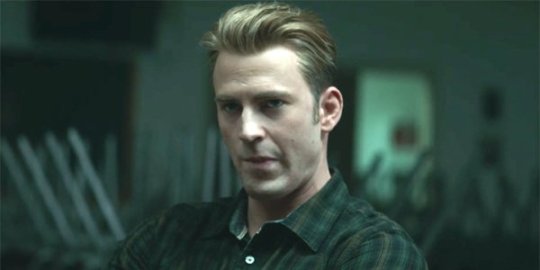
Last month, I came across a TikTok that proposed that Steve’s ending made sense because it existed within a causality loop. I would link the TikTok but I didn’t save it at the time and trying to find videos on that app is impossible. You think Tumblr’s search function is bad? 🙄 But I digress. The TL;DR of the video is that due to time travel and Steve choosing to go back in time to be Peggy’s husband, it created a causality loop where he was always meant to be her husband because he went back in time and stayed there. The TikToker supported his argument by using Harry Potter and the Prisoner of Azkaban (PoA), another film that uses time travel and has a clearly defined example of a causality loop. However, his argument is fundamentally flawed so I’m going to combine my knowledge of my two biggest fandoms to tell you why.
Continued under the cut because I have no chill. Beware, it's long.
To first tell you how Endgame (EG) doesn’t support a causality loop, we must establish how PoA does establish one and does it successfully. The TikToker specifically mentions the scenes that take place at Hagrid’s Hut surrounding Buckbeak the hippogriff’s execution, so we’ll look at those first. What the film does really well is establish early on that there is something weird going on well before anyone actually goes back in time. There are three things that happen in quick succession during this scene which sets up the causality loop we see later in the film. First, a rock flies through the window and breaks a jar. Second, another rock hits Harry in the back of the head. Third, once outside, Hermione hears a branch snap and thinks she sees ‘something’. There are also two additional moments later on in the film once the Harry, Ron, and Hermione have come out of the Shrieking Shack which should also be noted: a wolf howl that distracts Remus Lupin in werewolf form from attacking the group and somebody casting a full-bodied stag patronus at the edge of the lake to save Harry and Sirius from the Dementors.
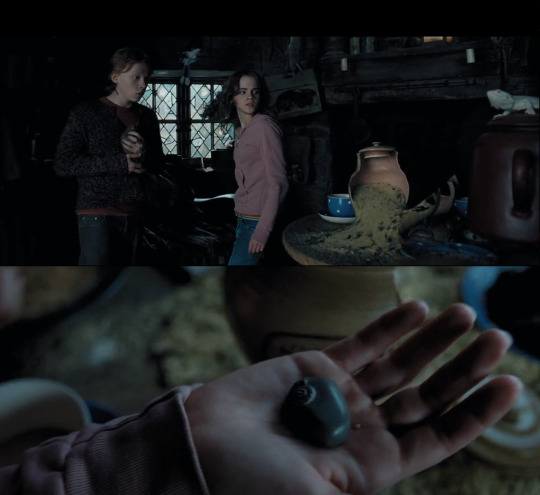
Of these occurrences, the first is arguably the most important because it does the most to establish that there is something going on outside of the Trio’s current understanding of their situation. The film makes a point to frame the jar breaking as Important Information the Audience Must Remember because it shows a visibly confused Hermione reacting to it as she picks up the rock for closer inspection and we the audience are given close up of it in her hand. Not only is it framed front and centre in the shot but the rock itself is very distinctive. It’s almost wholly smooth but for a swirl of fossil, thus marking it as not just any rock but An Important Rock To Be Remembered. This was an intentional choice by director Alfonso Curon because he uses this rock to connect this moment to its mirrored scene later on once Harry and Hermione use the Time Turner.
The audience and the characters find out about the causality loop at the same time. There are clearly stated rules of time travel that say that they aren’t to meddle with time but when Harry and Hermione see that Dumbledore, the Minister for Magic, and the executioner are on their way to Hagrid’s hut they panic because their counterparts aren’t leaving. Then, we see Hermione notice something in the pumpkin patch: a distinctive rock, smooth with a swirl of fossil. Again, we see have a close up shot with the rock centred to show its importance. Stylistically, it’s very similar to the shot we saw earlier in the film which gives the audience an emotional pay off for noticing the connection. When Hermione throws the rock and breaks the jar, it sets the causality loop in motion. The jar was always going to break because they went back in time to throw the rock that breaks it.
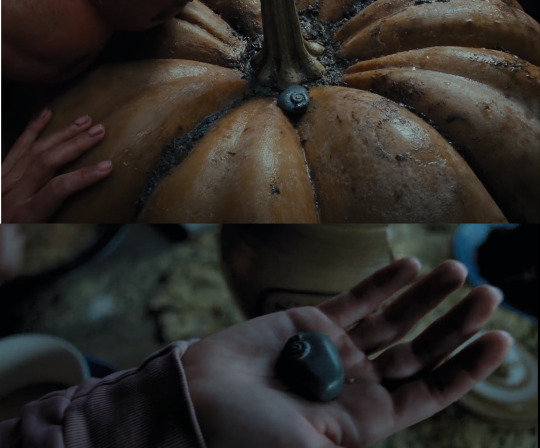
And it’s the same with all the other instances. Hermione throws the second rock that hits Harry in the back of the head to alert him to the fact they need to get out of the hut. Hermione snaps the branch and is almost seen by her counterpart in the past. Hermione makes the wolf call to distract Lupin from attacking. Harry, and not his father as he had assumed, casts the patronus to save himself and Sirius from the Dementors. But each of these moments are set up clearly in the ‘first run through’ to set up their payoff when the characters realise, ‘Oh, I did these things. They were always meant to happen.’ From a narrative standpoint, these are planned out moments to clue the audience into the fact that there’s something bigger at play. It keeps them ‘in the loop’ as it were.
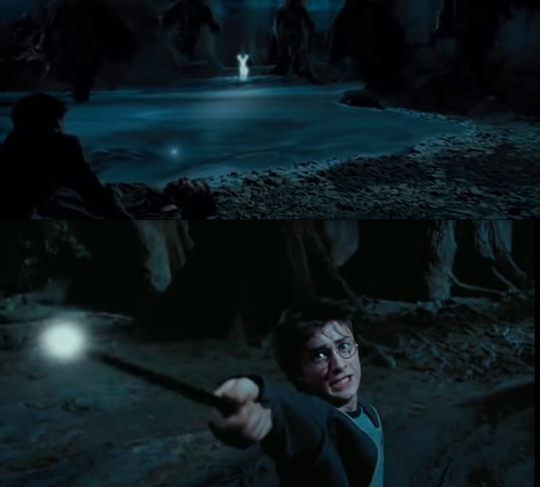
This doesn’t happen in EG.
To successfully have set up a causality loop that made sense and had the same kind of set up and pay off as we see in PoA, it would have had to have been established as early as 2014 in Captain America: The Winter Soldier (CA:TWS). This does not happen. One of the main themes of CA:TWS is moving on from the past. Peggy Carter herself even says, “I’ve lived my life, my only regret is that you didn’t get to live yours.” Then saying soon after, “Sometimes the best thing we can do is to start over.” Peggy’s character in Captain America: The First Avenger is set up as someone who acts as the backup/back bone of Steve’s own moral compass. When Steve falters at Azzano about what to about the captured 107th, Peggy is there to remind him of what is right. She serves a similar narrative function in CA:TWS. Steve is struggling with life in the present. He’s just seen the helecarriers and argued with Nick Fury about protection vs fear after the botched Lumerian Star mission. Morally, he’s in turmoil and has turned to Peggy for council because he’s trying to find purpose in world where his rigid morality seems to have no place.
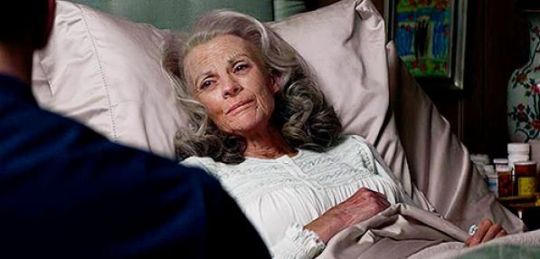
From the point of view of creating a causality loop, one would think that this scene in the hospital would be the place where an initial set-up could be made and alert the audience to the long term plan for Steve’s character. Instead, we have Peggy mourning the fact that Steve didn’t get to live his life the way it should have played out, and why would a woman who has supposedly been married to another version of Steve tell him to move on? In addition, when Steve visits the Smithsonian, he watches a video where he sees Peggy talking about how he influenced her life and how during one of his missions, he saved the man that would go on to become her husband. This is the only mention of Peggy’s husband in the entire franchise until Steve reappears as an old man at the end of EG.
Captain America: Civil War (CA:CW) also offers an opportunity to set up the causality loop at Peggy’s funeral but again, this does not happen. The only family we are introduced to is Sharon Carter, Peggy’s grand-niece. When it comes to filmmaking, every choice made is intentional. From the hair and makeup to the clothes, to the music used, everything in a film means something whether it is to further character development, world-building, or the plot. Filmmakers have a limited amount of time to convey a story and anything that doesn’t matter isn’t shown. Therefore, we can conclude from the text of the film that Peggy’s husband doesn’t matter to the narrative. The person in Peggy’s family who matters to the narrative is Sharon Carter which is why she is given prominence during CA:CW’s funeral scene. Had the causality loop been set up here, there would have been a defining moment like in PoA where the audience is clued into the larger story arc. Maybe someone says something, or he meets his older self, but that doesn’t happen. It should also be noted that apart from a small scene in Ant Man, Peggy isn’t mentioned again until EG.

In Endgame itself, the film still fails to set up a causality loop. It could be argued that this is the most important film for the set-up because this is when the audience gets the payoff. The first thing we see after the 5-yer time jump is Steve in a group therapy session for those that survived Thanos’ snap. Survivors share their stories and Steve talks about Peggy, a woman who has been dead in canon for 7-years and who died of old age. It’s incongruous and sticks out because narratively it doesn’t make sense for him to talk about her and not someone he watched disintegrate in front of his eyes. Steve watches his best friend and hundreds of others turn to ash around him and that film ends on his horrified face as he sits by his best friend’s ashes. Narratively, this is the thread that should carry through to EG but instead, he talks about missing his chance with Peggy. However, unlike PoA, there is no indication whether through dialogue or framing that clues the audience into Steve’s eventual ending at the end of the film.
Even when he goes back to the 70s, we see him looking mournfully at Peggy through the blinds in her office and a picture of him, pre-serum, on her desk. Steve and Peggy’s relationship prior to Endgame is supposed to represent the bittersweet loss of the life he could have had had he not sacrificed himself to the cause in CA:TFA. Then, since the audience knows from Steve and Peggy’s conversation in the hospital in CA:TWS that she moved on from Steve to live a happy life, we can assume that this picture is meant as nothing more than a fond memento of someone that meant a lot to her. Once more, there is no indication that Steve is ever meant to be her husband.
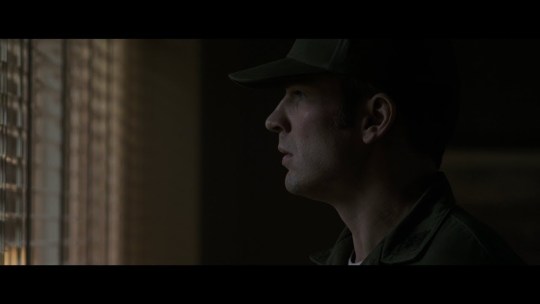
It’s impossible to infer a causality loop here in the same way as we saw in PoA. In PoA, there is a payoff for every single unusual or weird moment the story presents the audience before and after the use of time travel but this is something that’s completely absent from Endgame’s narrative. Steve himself doesn’t even vocalise a desire to go back in time at any point in EG nor at any point during the other films he appears in. In fact, when questioned by Tony Stark about the possibility of ‘going home’ in Avengers: Age of Ulton, he says, “The guy who wanted all that went in the ice 75 years ago. I think someone else came out.” While it is indicative of his unhappiness in the modern-day, it does indicate a level of acceptance of the fact that this is his life and he has to make his peace with it. He’s taken what Peggy said in CA:TWS on board. He’s starting over and moving on.
With time travel, and Steve choosing to stay in the past came the fan theory that one of the pallbearers carrying Peggy’s casket in CA:CW is Old Man Steve, her husband. When presented with this fan theory, writer Christopher Markus said during an interview with the LA Times at SDCC 2019,
“I would very much like that. There is no set explanation for Cap’s time travel . . .I mean, we’ve had public disagreements with [directors Anthony and Joe Russo] about what it [time travel] necessarily means, but I love the idea of there being two Steve Rogers in the timeline. One who lived a long life with Peggy and is in the background of that funeral scene watching his young self carry his wife’s coffin up. Not just for the time travel mumbo jumbo of it, but for the just weird, personal pain and satisfaction that would be happening between two Steve Rogers there. I kind of love it.” [emphasis mine]
This shows that unlike in PoA there was no intention of creating a causality loop prior to Markus writing EG with his writing partner Stephen McFeely. In fact, it makes clear that the actual rules of time travel were in contention and that even those making the film didn’t have a unified idea of what they wanted to create in the first place. The fact that there is confusion surrounding EG's time travel is due to the fact that the people behind it, didn't seem to know what they were writing or consider the consequences of it.
What all of this shows is that an argument of a PoA style causality loop doesn’t hold water. The film doesn’t support it, nor do any of the previous films, because there aren’t any indicators for the audience to latch onto. There is no moment of the rock breaking the jar, or the patronus chasing away the dementors, no moment where that the audience is told to hold into this information for later because there’s some timey wimey stuff going on. Ultimately, when examined, there is no set-up for a causality loop that supports the theory he was always supposed to go back and be Peggy’s husband, particularly when examined against a film that successfully lays it out from the start.
Right, the more academic (lol) part of this post is done. I just want to address one more TikTok that bothered me because I have opinions and MCU Captain America is my Mastermind specialist subject.
The TL;DR of this one was that Steve’s ending made sense because he got out of the fight and was at peace and that that has been the ultimate goal of his character arc. This person argued that Steve used the Avengers to distract himself from the fact that he’s this man out of time and he can’t find peace without a fight which to some extent, I agree with. I don’t deny that that is a major driving force to his story. We see that in Age of Ultron with his WandaNightmare. I don’t deny that that is key to his character. However, this creator then made a comment at the end of this video to the tune of, ‘bUt BuCkY iS hIs StOrY aRc’ and tried to play it off like this wasn’t true or that people were wrong to think that this is the case.
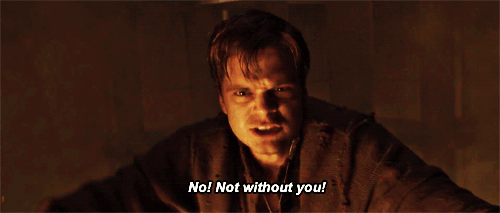
These two things aren’t mutually exclusive. They’re both true. They’re intertwined. But you cannot say that Bucky Barnes isn’t at the heart of Steve Rogers’ story. Bucky was the catalyst for every single one of Steve’s movies. He becomes CA because of Bucky. He goes against SHIELD because of Bucky. He defies 107 countries and the Sokovia Accords because of Bucky. You take Bucky out of the equation and what do you have? What happens in those films if you take Bucky Barnes out of the equation? Viewing it objectively, and even without shipper goggles on, you simply cannot sit there and claim that Bucky Barnes isn't a defining component to Steve’s story. Steve Rogers is motivated by Bucky Barnes. Steve Rogers is motivated by the depth of their relationship and the fact that Bucky Barnes is one of the few things connecting his new present to his old life.
You can definitely see the fact that Steve is uncomfortable in the modern world. He doesn’t address any of his trauma but he still attempts to move on. However, if they wanted him getting out of the fight and finding life as a civilian to be the natural end to his story arc then there was a way to do it which didn’t require him going back to Peggy. It would have been a better and more satisfying ending if he’d actively chosen to retire because I often see the argument that him going back to Peggy is him finally allowing him to be selfish after shouldering so much over the past decade or more. If Steve chose to retire and put himself first, then that sends a better message. He’s still getting the chance to ‘be selfish’ but he’s not throwing the life he’s built away. At this point in EG, he’s spent a huge portion of his adult life in the modern-day. This isn’t the future for him anymore, it’s the present and he’s lived a life and made real connections with people. The MCU does a piss poor job of showing the interpersonal relationships between the Avengers but he is at least shown to be friends with Sam, Nat, and Bucky.
But he goes back to a delusion. Or an idea of something that was never his in the first place.
When I see people make these videos and share their opinions, I can see their points but it’s like they’re taking EG on its own when that's impossible. Endgame only ‘works’ if you have the context of 10 years’ worth of films. You have to at least be somewhat familiar with the characters, who they are and what they’ve done up until now to be able to make sense of it.
However, in saying that, they wrote and filmed the movie in a way to make you think you didn’t have to take into account anything you’ve seen in the past ten years. If you only watch Endgame, you only see a grieving man mourning the love he never had. You see a man, regretful that he didn’t get to be with woman he loved. So at the end, of course it would make sense that he goes back to her. But you can only do that if you completely divorce Endgame from its ten-year canon and in a franchise like this where they make a big deal about everything being interconnected, it simply doesn’t work. Steve’s story arc in Endgame is incongruous to the narrative arc we’ve been presented in previous films.
Ultimately, Endgame is a movie you’re supposed to watch once and then not think about again. It’s made for that first viewing when everything is shocking and exciting because if you stop to think about it even a little bit, it falls apart under scrutiny.
Finally, I think that the downfall of a lot of these ‘Steve’s ending makes sense’ posts is that made by people who are most certainly MCU fans but not Steve Rogers fans and it shows.
#in this essay i will#endgame wank#anti endgame#for the filters#steve rogers#my writing#because this i didn't spend my afternoon on this for nothing#marvel#stevie#angelblue007
622 notes
·
View notes
Text
My Top/Bottom “10″ Moments of Avengers: Endgame [Spoilers Ahead]
In no particular rank…
The Good and the Legendary Moments (I had a hard time limiting it to 10, clearly there are more)
Cap’s “don’t do anything stupid while I’m gone” and Bucky’s reprise “How can I? You’e taking all the stupid with you…I’m gonna miss you.” He knows his friend well enough through all the years that he understands and accepts (and in that second, we do too) that Cap’s not coming back the fast way, that he’s chosen the slow path to the end of the line.
Sam inheriting the Shield from Rogers with Bucky’s blessing, “go to him.” Because Bucky knows that, even though they are the best of friends and fellow supersoldiers, Sam has kept an eye on Steve while Bucky was MIA, and that puts him in a reasonable position to inherit the mantle.
Post-snap “5 years later” we see Steve taking up Sam’s role as a group counselor, our first hint at the transition of roles later to come, capped off with Sam emerging from the portal with a timely “on your left.”
Hawkeye’s opening: the very real, personal, character driven moment in which Clint is with his family, and shortly thereafter the snap is dragged out of retirement kicking and screaming.
Tony’s and Stark’s intellectual interactions which began as animosity and conlcuded as a kind of mutual admiration “is this the one we win? / if I tell you, it won’t happen (almost apologetically because Strange knows what is about to happen and is letting it go forward anyway),” culminating with “I am Iron Man” and thunderous applause.
EVERYTHING having to do with Tony’s daughter Morgan. From her interaction with Jon Favreau aka Happy about cheeseburgers, to finding her dad’s suit mask, to Stark calculating time-travel while doing the dishes, then swearing, then swearing Morgan to secrecy, and most heartrendingly “I love you 3000.” Tony’s father-daughter relationship is one of those key character pieces that elevates this whole film from a Marvel capstone to a best picture.
Steve’s moment watching Peggy even though he never interacts with her, in 70s at the Pymm/Stark research facility. It’s the most poignant foreshadow of his destination to come. He doesn’t make that mistake twice.
Natasha’s character development. Five years later, even as she falls apart spinning her wheels about deep sea tectonic quakes, and she still cuts her peanut butter sandwich corner to corner as if daring “Nick” Fury to unsnap himself and say “no, let me show you how it’s done.” Two great insights into the depth of their familial relationship courtesy of the Captain Marvel film. Also a shout-out Steve’s subsequent offer to cook Nat dinner. Steve and Nat always carry great character moments, all the way back to CA:WS when she was setting him up on dates.
The small moments of battlefield humor that were just enough not to break the moment: Steve calling out to Parker “Hey Queens,” Peter engaging the Spidey suit kill mode and then him curled up in the fetal position, Wong’s deadpan “were you expecting more?” Jesus, just give Wong an entire act in the next Doctor Strange movie and I will be happy. I adore him. PS: what a pleasant surprise the way the Russos put Tilda Swinton in as Sorcerer Supreme opposite Banner. That was just the right character for the exposition on the perils of altered reality.
The overarching theme of premonitions as it deals with crossing through the quantum realm into the past, and the ensuing parallels from what we’ve already seen in the Marvel past. Specifically the ‘premonitions’ that past-Nebula had when future Nebula past through time and how they could access each others memories, which puts the interesting and poetic possibility that Tony’s dreams/visions this whole time (ex: Infinity War’s “[Pepper] we had a kid, it was so real”) were never a direct result of Thanos, but rather his travel through time. The Time Travel element also relates to parallels where Howard Stark meets “Howard Potts” and the potshots at his questionable beard. Tony meets Stark Sr. at the exact right moment when Maria is expecting and they relate to the perils and joys of fatherhood: “there’s no manual for this/ there’s nothing I wouldn’t do for this kid / you did your best”, which sets up Howard’s video journal to Tony and Tony’s post-battle video journal to Morgan as even more powerful together, in the context of each other, then when we saw the original Iron Man films. Endgame brings new depth / meaning to those historic moments.
Honorable mention to Thor who, after the “I aimed for the head” reprise, developed a sense of crippling anxiety and notable weight gain within his depressive reclusiveness, and still managed to suit up and be a hero anyway. While I didn’t necessarily like the fact that Thor dealt with his PTSD through hardcore gaming, I like the direction that the Russo’s steered him after subsequently calling him an “Angel Pirate” in Infinity War. The message, by contrast, that you don’t have to look a certain way, or step into the role that everyone expects of you (King of Asgard), or even have your shit together to be heroic - you just have to step your foot out of the door and face the day - is damn brilliant.
Honorable mention #2: Rocket’s speech to Thor “you’re not the only person to have ever lost someone.” Great BroTP, with tha dash of crossover Whovian.
Honorable trifecta: Steve Rogers wielding the Mjolnir and FINALLY. FIN-A-LLY “Avengers: Assemble!” What great standing ovation moments.
OVERALL: What this film misses in building the tension (it cycles down before it revs up), it makes up for by setting up the small, poignant character moments that show off the emotional talent of these actors in a way that I’ve never seen with this impact before: Infinity War, Black Panther, and Civil War being the runners up.
The Disappointing:
The “Smart Hulk” / Ant Man “little man” gag didn’t work for me. The autographs, the tacos, the test time travel run. It got stale very quickly.
Speaking of Ant Man, by contrast to Tony and Morgan, Scott Lang’s reunion with his daughter after 5 years didn’t hit the emotional note it was meant to. It make sense how they use Lang as perspective of “what’s going on / fish out of water” to drive the aftermath of the snap home and to introduce quantum science. But out of all the characters, I was probably least invested in him.
The female-led gauntlet scrimmage in the final act across the battlefield felt like more of a “set piece” rather than really earned emotion by comparison to Infinity War’s female tag team (Okoye, Nat, and Wanda) against Proxima, where Nat defends Wanda and says “she’s not alone.”
I didn’t like the script choice of killing the complex, Infinity War version of Thanos so quickly (while it was unexpected and paid off big time for a hot second when Thor’s said “I aimed for the head”) and taking on Past-Thanos. For me, it undermined and underdeveloped the villain. I would have wanted a deeper understanding of “The Garden” and flashbacks to Titan or young Gamora, or even more interaction between him and his daughter present-Nebula, before the war-torn Thanos gets the 1-2 chop, but I understand the choice given time constraints of a three hour film.
Hawkeye’s ronin montage: his revenge against criminals in the post-snap era, “why are you here, why did you get to survive and my family didn’t?” could have had the ability to be powerful, especially considering that Natasha has been keeping tabs on him and didn’t intervene until critical mass. But instead, I feel like it was mishandled, too thematic, it takes your out of the moment like a set piece.I loved Natasha’s bond with Clint up to and after the ronin sequence, it took two characters that I was on the fence with and got me emotionally invested in them as a team, I just hated the montage itself.
No Vision? What?! Hardly even a mention in this film except for Wanda’s wrath when she is resurrected and brings that house down on Thanos, but even then Thanos essentially said “who the heck are you and what did I do to make you mad?” completely taking the steam out of Vision’s fall. Hopefully Phase 4 addresses / fixes that.
No Loki resurrection? At the very least, no past-Loki dialogue?! Come on. I thought for a second, when Loki escaped STRIKE custody in the alternate timeline with the tessaract, that maybe the team had created a and untrimmed time branch (I still think they did, because if Rogers returned the Stone to 1970, it doesn’t fix the later botched attempt to steal it, so maybe there’s a branch reality where Loki is alive with witty trickster lines and I’ll cling to it). Then I was fooled again when Mjolnir went flying through the air I thought perhaps that Loki Odinson had returned and was worthy to wield it through his selfless sacrifice (I was only momentarily disappointed / awed to see it was Cap instead). Again, Phase 4, give me some help here!
The fact that Black Widow got no proper funeral sendoff, concluding Natasha’s long history of under-use throughout the entire Infinity Saga. Don’t get me wrong: I understand her soul stone sacrifice, and in a way I understand the people who say, “don’t take that away from her, it’s powerful.” It is. She comes from a manipulative, violent background that made her who she is and good at what she does. Throughout her history, she never had family, which she admits: “Red Skull knew my father’s name, that’s more than I ever did.” So it makes the choice more poignant that she built a family around herself and did whatever it took to keep them safe and united. That said, I wasn’t (until this film) necessarily invested in Black Widow like I am the other Avengers characters, but she’s had some great moments with Clint (I still want to see the Budapest mission, and the Iran extraction that Bucky compromised) and Rogers (Endgame: I’ve been telling everyone to move on, but not us. Winter Soldier: their getaway from Hydra-infested SHIELD) and Fury. Which is why I HATE that her only tribute was a bunch of men standing around lamenting over her (while simultaneously being oblivious to the Nebula swap, seemingly incapable of intelligent script development by McFeely and Markus around those two female characters). It would have at least been fitting if they had more regrets “why didn’t we know her better, we were supposed to be her family”, “why didn’t we appreciate her while we could” or her name added to an altered “fallen” monument. There was no payoff to her chemistry with Bruce, and no final closure with un-dusted Fury to pay his respects, which would have been a small but vastly fitting gesture. WHAT A WASTE.
Captain Marvel’s use in the film as essentially a ballistic, ship-destroying missile and her anticlimactic Thanos battle. Why use her at all in this film if it’s going to be as a plot device? She could have had potential opposite Thor, and I’ll argue that she should have been Banner’s tag-team person to bring him out of new-Asgard exile. But the Russos and writing team missed that opportunity as well. Danvers’ appearance felt hollow.
The pacing / cycle down of tension post-opening sequence was off-putting to me. I was revved up to level 10 ready to go to 11, but had to dial back down by half (ex: even though I love the montage of Tony and Nebula playing table football, it crawls by comparison to the expectations set right after Infinity War). The tonal shifts between the three acts of Endgame made me feel like I was watching two good films as opposed to the one great, legendary film I was expecting. Perhaps I came in to Endgame too pumped and needed to be more in the moment, because this displaced feeling was very strong on initial viewing, but faded the second time I saw the film.
Honorable mentions: Parts of the alternate reality “time travel” sequence really bothered me: ie the battle of New York (from A1). Hulk smash didn’t work for me, though Hulk “take the stairs” and Stark’s minor cardiac dysrhythmia corrected by Thor’s hammer were funny. Also Cap’s “I found Loki” was priceless. So I guess you have to absorb the disagreeable montages of time alterations to enjoy the good, like Banner and the Sorcerer Supreme, Howard and “Howard.”
Honorable mention #2: This movie did a hell of a job at all the couple / BroTP splitting, WTH! Steve and Sharon never stood a chance, Wanda and Vision, Banner and Natasha, Steve and Bucky, Steve and Sam, Thor and Loki, Gamora and Quill. Dammit, I hope Phase 4 at least patches up a few holes in these ships before sending in the speculated new ensemble of comics characters.
In SUMMARY: as my dislikes wane with time and my likes grow in retrospect with each saga part I rewatch, and each time I revisit A4 in theaters, I think that Avengers: Endgame, while not quite my favorite installment, will stick with me forever. What a decade! And my next great joy will be 10…15…20 years from now, when I get to meet a kid, let’s call her Morgan, who’s never seen an MCU film before and vicariously relive that first joy watching it with them. To the end of the line.
I can’t wait.
#spoilers#avengers endgame#avengers endgame spoilers#top 10#endgame#endgame reaction'd#infinity saga#mcu#mcu phase 4#to the end of the line#i love you 3000#tony stark#captain america#sam wilson#bucky barnes#black widow#hawkeye#bruce banner#a decade for the nerds#nerdlife#marvel#stan lee the legand#the russo brothers#jon favreau#kevin fiege#a standing ovation to everyone involved in these 22 glorious stories
8 notes
·
View notes